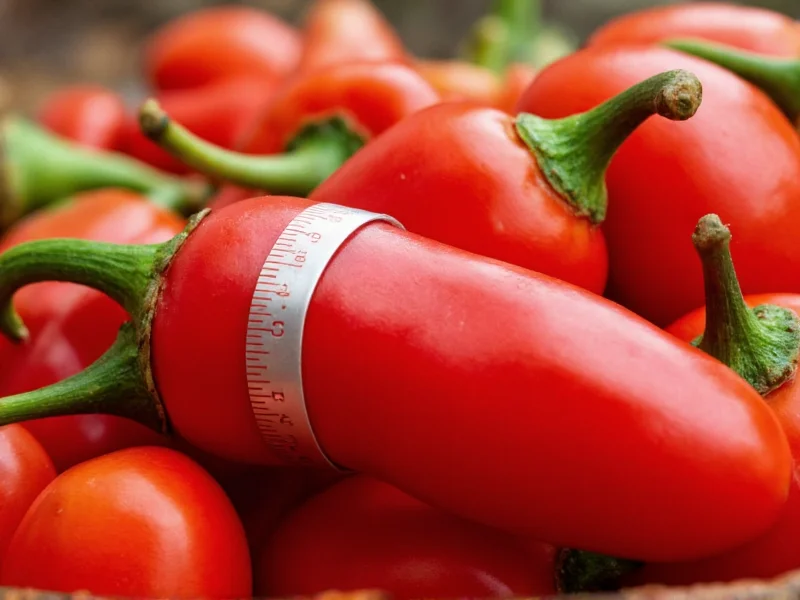Understanding how chilli heat is measured unlocks the science behind one of the world's most beloved culinary sensations. For centuries, humans have enjoyed the fiery kick of chili peppers, but only in the last hundred years have we developed reliable methods to quantify this heat. Whether you're a food scientist, chef, or simply a spice enthusiast, knowing how to interpret chilli heat measurements helps you navigate the vast spectrum of spiciness from mild bell peppers to the world's hottest varieties.
The Origins of Chilli Heat Measurement
The story of chilli heat measurement begins with Wilbur Scoville, a pharmacist who developed the Scoville Organoleptic Test in 1912. This pioneering method relied on human taste testers to determine heat levels through dilution. Panelists would taste solutions of chili extract diluted in sugar water until the heat became undetectable. The degree of dilution required determined the Scoville rating - a pepper requiring 5,000 times dilution would rate 5,000 SHU.
While groundbreaking for its time, the Scoville test had significant limitations. Human taste perception varies dramatically between individuals, and factors like palate fatigue could skew results. Despite these flaws, the Scoville scale became the industry standard for decades and remains the most recognized measurement system among consumers.
Modern Scientific Measurement: HPLC Analysis
Today, the scientific measurement of chilli heat primarily uses High Performance Liquid Chromatography (HPLC), a laboratory technique that precisely identifies and quantifies capsaicinoids - the chemical compounds responsible for heat in chili peppers. HPLC separates the various capsaicinoids (including capsaicin, dihydrocapsaicin, and others) and measures their concentration in parts per million.
The results from HPLC analysis are then converted to Scoville Heat Units using a standardized formula: 1 part per million of capsaicin equals approximately 15-16 SHU. This conversion allows modern scientific measurements to remain compatible with the historical Scoville scale that consumers recognize. HPLC provides objective, repeatable measurements unaffected by human subjectivity, making it the gold standard for research and commercial applications.
Understanding Capsaicinoids: The Science Behind the Burn
Chilli heat comes primarily from a group of compounds called capsaicinoids, with capsaicin itself accounting for about 70% of the heat sensation. Different chili varieties produce varying ratios of six major capsaicinoids, which explains why two peppers with identical Scoville ratings might produce different heat experiences - one might feel more immediate while another builds slowly.
The heat sensation occurs when capsaicinoids bind to TRPV1 receptors in the mouth and throat, triggering a neurological response interpreted as heat or pain. Individual sensitivity to these compounds varies based on genetics, previous exposure, and even cultural factors. This biological variation explains why "how spicy is too spicy" differs dramatically among people.
| Chilli Variety | Scoville Heat Units (SHU) | Typical Use |
|---|---|---|
| Bell Pepper | 0 SHU | Raw consumption, cooking |
| Jalapeño | 2,500-8,000 SHU | Salsas, nachos, pickled |
| Habanero | 100,000-350,000 SHU | Hot sauces, Caribbean cuisine |
| Ghost Pepper (Bhut Jolokia) | 800,000-1,041,427 SHU | Extreme hot sauces, challenges |
| Carolina Reaper | 1,400,000-2,200,000 SHU | Specialty hot sauces, novelty |
Practical Implications of Heat Measurement
When understanding chilli heat measurement methods, it's crucial to recognize that Scoville ratings represent potential maximum heat. Actual heat in individual peppers varies based on growing conditions, soil composition, climate, and even position on the plant. A jalapeño grown in optimal conditions might reach 8,000 SHU, while the same variety in less ideal conditions might only reach 2,500 SHU.
For food manufacturers, precise measurement of chilli heat ensures product consistency. Hot sauce producers use HPLC testing to maintain consistent heat levels across batches. Chefs use Scoville ratings to balance flavors in recipes, understanding that adding a small amount of a high-Scoville pepper can dramatically alter a dish's heat profile without overwhelming other flavors.
Common Misconceptions About Chilli Heat
Several myths persist about chilli heat measurement and experience. Many believe that the seeds contain the most heat, but in reality, the highest concentration of capsaicinoids exists in the white pith (placenta) surrounding the seeds. The seeds themselves absorb capsaicin but don't produce it.
Another misconception is that milk neutralizes chili heat through fat content alone. While dairy does help, the real hero is casein, a protein that binds to capsaicin and washes it away from receptors. This explains why non-dairy alternatives like soy milk are less effective at cooling the burn.
Measuring Heat Beyond the Laboratory
While professional measurement requires sophisticated equipment, consumers can make rough assessments of chilli heat through careful tasting. Start with a small piece, wait 15-30 seconds for the heat to develop, and note both the immediate impact and lingering effects. Keep in mind that individual tolerance varies, so your personal heat scale may differ from others'.
When cooking with chilies, remember that heat distribution isn't uniform. Finely chopping distributes capsaicin more evenly than leaving pieces large, and cooking can sometimes intensify heat as cell walls break down and release more capsaicinoids into the dish.











 浙公网安备
33010002000092号
浙公网安备
33010002000092号 浙B2-20120091-4
浙B2-20120091-4